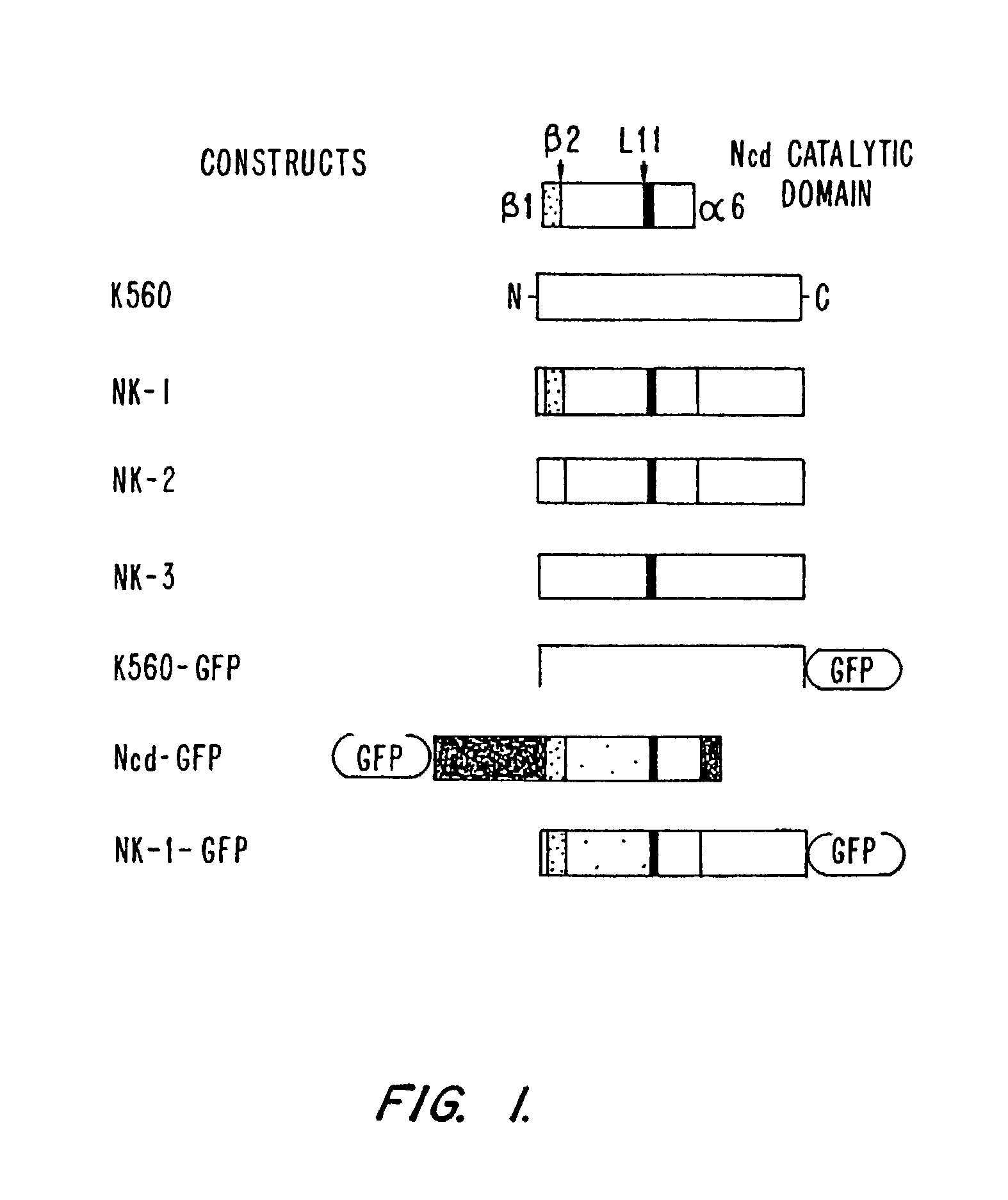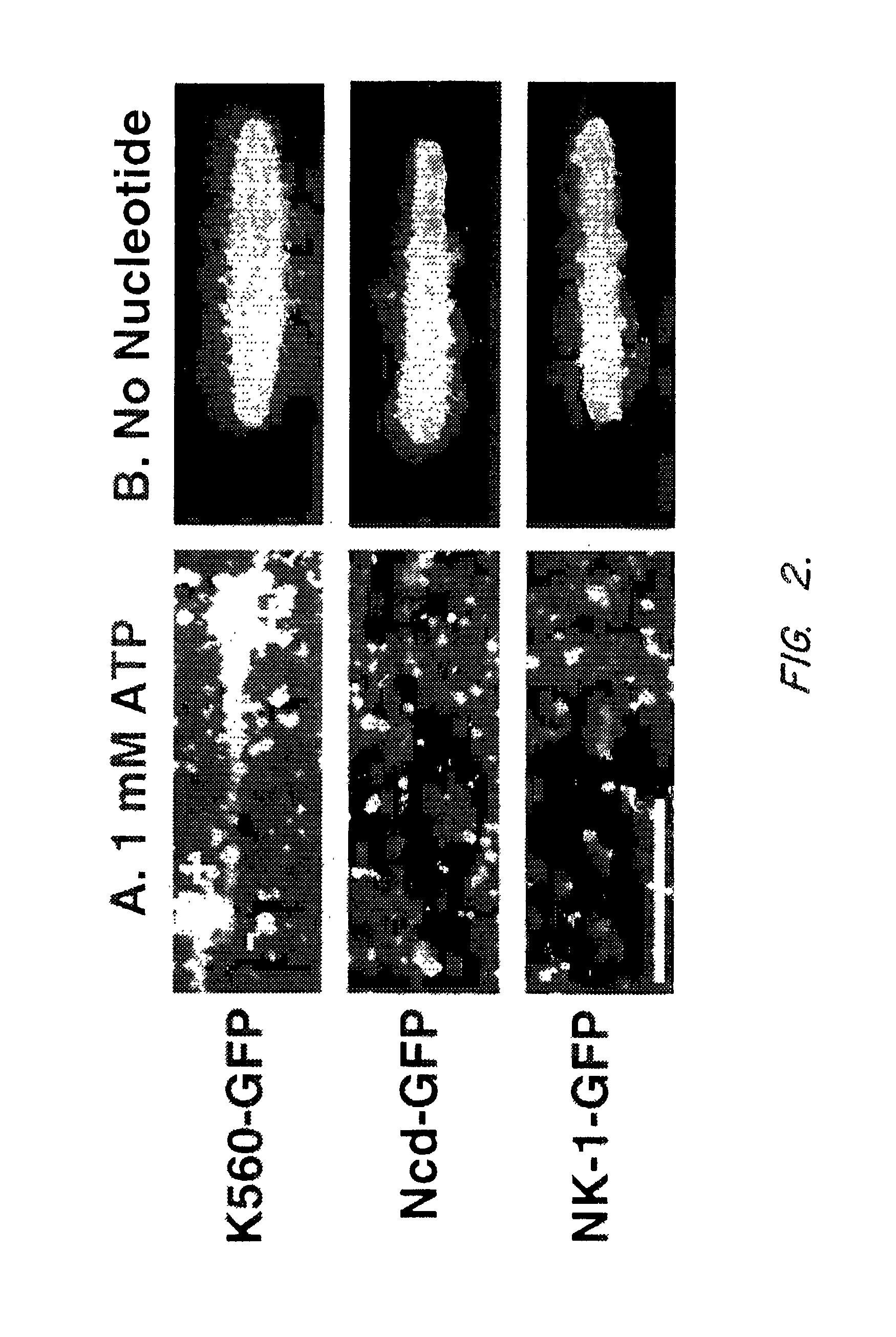Assays for detecting modulators of cytoskeletal function
- Summary
- Abstract
- Description
- Claims
- Application Information
AI Technical Summary
Benefits of technology
Problems solved by technology
Method used
Image
Examples
example 1
Observation of Kinesin Motor Binding to a Surface-Adsorbed Microtubule Detection by Total Internal Reflection Microscopy and Modulation of that Binding by Nucleotide
[0165]To observe single motor molecule binding, motor-GFP fusions were prepared. Previous studies had shown that single GFP molecules (the Ser65Thr variant) can be detected by TIR microscopy (Pierce et al., 1997, Nature 388: 388). For the wild-type kinesin and the NK-1 chimera, GFP was fused C-terminal to residue 560. In the case of Ncd, GFP was fused N-terminal to residue 236, which retains ¾th of the Ncd coiled-coil stalk and the complete motor domain but lacks the N-terminal domain that bundles microtubules (Chandra et al. (1993) J. Biol. Chem. 268: 9005-9013.). This GFP fusion method is advantageous compared to fluorescent dye modification, which tends to inactivate the Ncd catalytic domain. Hydrodynamic and single fluorescent spot intensity analysis indicated that K560-GFP and Ncd-GFP are dimers under conditions of ...
example 2
Reversible, Site-Specific Immobilization of Arginine-Tagged Fusion Proteins on Mica Surfaces
[0181]This example describes the specific binding of polyarginine tagged proteins to atomically flat negatively charged mica surfaces. The polyarginine tags were expressed as fusion proteins. It is shown herein that the arginine (e.g., hexaarginine) tagged proteins bind to mica via the Arg-tag based on ion exchange of naturally occurring potassium cations. Only nonspecific binding was observed with the control protein that is free of the Arg-tag. This novel technology facilitates the uniform and specific orientation of immobilized proteins on a standard substrate used for many surface-related applications.
[0182]A) Materials and Methods
[0183]Muscovite mica was obtained from Provac (Liechtenstein). The plasmid pGFPuv was from Clontech (Palo Alto, Calif.) and the vector pET28a(+) was from Novagen (Madison, Wis.). All other reagents were from Sigma Chemical (St. Louis, Mo.) and of highest availab...
example 3
Solution-Phase Assays: Use of ATPase Assays in Screening Microtubule Binding Agents
[0195]A) Preparation of Sponge Extract for Screening.
[0196]The sponge Adocia (Haliclona) sp. (Collection #95-100) was collected in Palau, Western Caroline Islands, and was quickly frozen. The frozen sponge (225 g) was diced and steeped in a mixture of dichloromethane (300 mL) and methanol (1 L) for 24 h. The solids were removed by filtration and the solution was reduced in volume to 300 mL and extracted with dichloromethane (2×200 mL).
[0197]The aqueous phase was lyophilized to yield a pale yellow powder. The powder (1.0 g) was chromatographed twice on a reversed phase C18 Sep-Pak, using a gradient of 30% MeOH in H2O to 100% methanol (MeOH) as eluant, to obtain pure fractions containing adociasulfate-1 and adociasulfate-2 and a mixed fraction containing adociasulfates. The mixed fraction was separated by reversed phase HPLC using 1:1 MeOH—H2O as eluant. Pure fractions were combined to obtain adociasulf...
PUM
 Login to View More
Login to View More Abstract
Description
Claims
Application Information
 Login to View More
Login to View More - R&D
- Intellectual Property
- Life Sciences
- Materials
- Tech Scout
- Unparalleled Data Quality
- Higher Quality Content
- 60% Fewer Hallucinations
Browse by: Latest US Patents, China's latest patents, Technical Efficacy Thesaurus, Application Domain, Technology Topic, Popular Technical Reports.
© 2025 PatSnap. All rights reserved.Legal|Privacy policy|Modern Slavery Act Transparency Statement|Sitemap|About US| Contact US: help@patsnap.com


